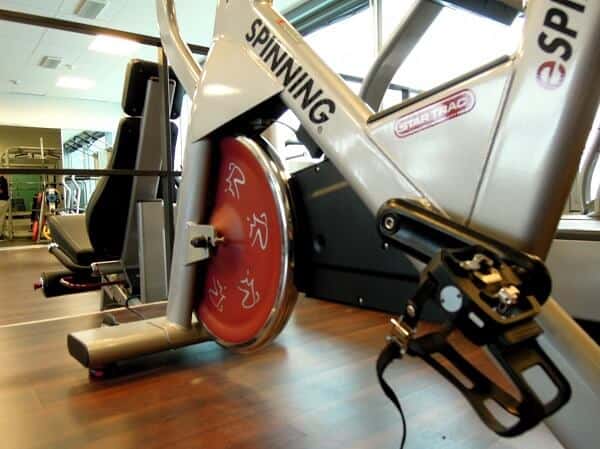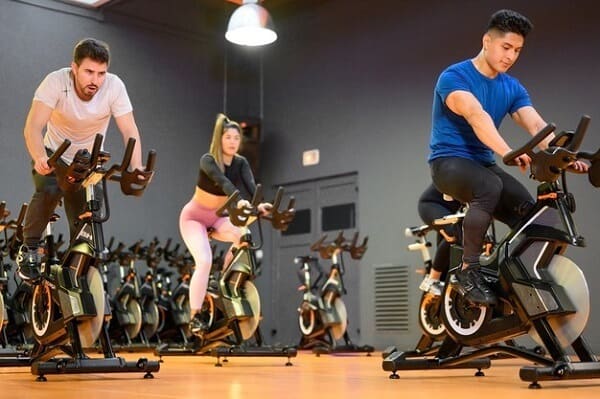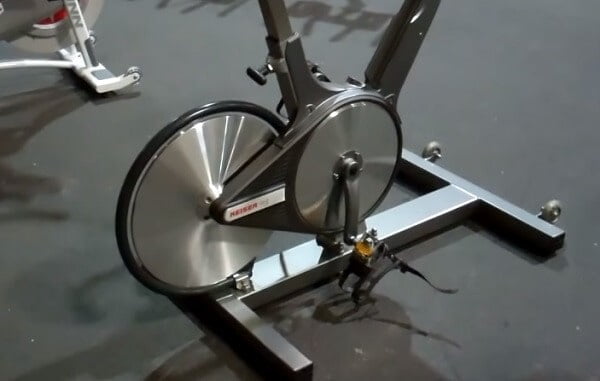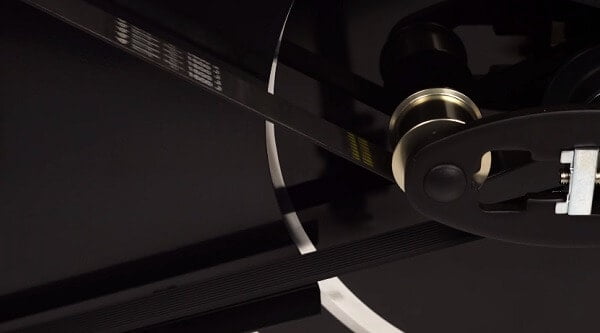A flywheel is the large rotating disc that you see in a spin bike. It is arguably the most important component of a spin bike. The flywheel helps to simulate the same pedal feeling that you get from riding an actual bike outdoors. On an outdoor bike, a lot of force is initially required to get the bike moving. Once you are up to speed, the bike will keep going for some time even when you stop pedaling. A flywheel makes this possible on a spin bike by storing energy.
You will often see exercise bike manufacturers mention the flywheel weight on their products. The question is, how much weight you should look for in a flywheel. As a rule of thumb, heavier flywheels are better. Anywhere between 16 and 20 kg is optimum for most people who use a spin bike at home. Commercial spin bikes at gyms might have heavier flywheels. For a seamless pedaling motion, try to avoid anything less than 14 kg.

Why a flywheel is required
If you were to start cycling without a flywheel, at the point when the cranks are parallel to the ground, maximum force is exerted and the pedals would move very fast. Whereas when the feet are near the bottom or top of the stoke, less force would be exerted and the pedals would slow down. This translates to a choppy, up-and-down motion which is not desirable and might actually lead to injuries.
With the addition of a flywheel, it is harder to get it spinning, and therefore, the pedals won’t go too fast off the get-go. Also, the momentum of the flywheel keeps the pedals moving at a near-constant speed when you cannot exert as much force on them. Simply put, the flywheel stores some of the kinetic energy when you push down on the pedals and releases it when you are not. This leads to a smooth, continuous motion that feels natural.

The science behind a flywheel
So why does the weight of a flywheel matter? Well, kinetic energy, also known as the energy of motion, is dependent on mass and velocity. Hence, if you increase either the mass or the velocity of an object, you can increase the amount of kinetic energy it has. The formula for kinetic energy is as follows:-

According to this, if you double the mass of a flywheel while keeping the velocity of rotation the same, the amount of energy it can store doubles. Therefore, a heavier flywheel will provide a smoother and more realistic motion. However, it is worth noting that doubling the velocity of a flywheel while keeping a constant mass will increase the kinetic energy four times. Keep this fact in mind for now as it will become more relevant later on in this article.
Best flywheel weight
No specific weight can be considered the gold standard for a flywheel. The general rule is that a heavier flywheel is better. Most spin bikes have a flywheel weighing around 30-50 lbs. or 14-22 kgs. Anything lower than this range is not recommended for a spin bike in particular. The reason being that a spin bike is meant for high-speed pedaling and the motion needs to be as seamless as possible. Still, there are advantages and disadvantages to both heavy and light flywheels. Note that a flywheel is usually perimeter-weighted to make the rotation even smoother.
Heavy vs Light Flywheels
Flywheel comparison
| Heavy | Light |
|---|---|
| Smooth and natural feeling motion | More of a jerky motion |
| Does not cause any injuries | Might be stressful for joints resulting in injury |
| More expensive | Less expensive |
| Makes it more difficult to move the spin bike | Easier to move the spin bikes |
Why a light flywheel can sometimes be good
With all that said, a lightweight flywheel does not necessarily mean a bad thing. In fact, depending on the design of the drive mechanism it can be just as good as a heavy one. Some brands have come up with an ingenious design that allows the flywheel to be less than 10 lbs.
In this design, the pedal wheel is much larger which creates a higher gearing ratio. This in turn rotates the flywheel a lot faster than on other spin bikes. Recall that an object can have a large amount of kinetic energy by increasing the speed of rotation. By utilizing this principle, they can create an effective flywheel that does not weigh too much.
The advantage of this system is that the overall weight of the spin bike is reduced. Moreover, since less material is required for the flywheel, the cost of the machine also comes down.

The positioning of a flywheel
On a spin bike, the flywheel can either be placed at the front or the back. Most models have it at the front because of the relatively large weight. This makes the machine easier to move around the house. However, this places the flywheel underneath the so-called “sweat zone”. This is the zone where your sweat constantly drips down from your face. Constant exposure to moisture can cause some rusting or other forms of damage in the long run. But this can be easily avoided with regular cleaning. Some spin bikes have the flywheel at the rear, away from all the sweat. However, those flywheels are usually much lighter.
Frequently Asked Questions
Q1. Does a heavier flywheel mean higher resistance?
Ans.: The weight of a flywheel has nothing to do with the resistance level. As you might already know, the resistance is set either by friction with a felt brake pad or by magnets placed close to the flywheel. A heavy flywheel is slightly more difficult to get started. But once it is rotating, it can keep spinning with little extra effort. This means that even beginners can exercise with large flywheels without it feeling too hard. You only need to check the resistance levels on a spin bike to determine whether it is suitable for your fitness level.
Q2. Which drive mechanism is best for a spin bike?
Ans.: There are two types of drive mechanisms – belt drive and chain drive. A belt-driven mechanism is generally considered to be better. This is because it is smoother and runs virtually silently. Also, a belt does not require much maintenance at all. A chain-driven mechanism is an older design that makes some noise and needs to be maintained (e.g. lubrication) from time to time. However, a chain is quite a bit cheaper than a belt. If you are low on budget, there are some good quality chain-driven spin bikes that you could try.

Q3. What other factors should I consider before buying a spin bike?
Ans.: The flywheel weight plays an important role in helping you choose a spin bike. However, it is not the only factor. There are plenty of other features that you should look for in a spin bike. The perfect spin bike should:-
- be stable and durable enough for high-intensity cycling.
- have a fully adjustable seat and handlebars to accommodate you and others who might use the machine.
- have a smooth and quiet drive system, so it feels comfortable to use and does not annoy others around you.
- have a resistance range that is suitable for your fitness level.
- be able to keep track of your stats such as speed, distance, calories, etc.
have any other convenience features that you might need.
Conclusion
Now you know what range of weight you should look for in a spin bike flywheel. In general, a heavy flywheel is superior. However, we have seen that a light flywheel can also deliver great performance when the drive system is designed properly. The best way to know if the flywheel weight is suitable is to try out the spin bike in person if possible. Overall, as long as the pedaling motion is smooth, and feels like a real bike, there’s no need to worry about the weight too much.
